Last Updated: December 21, 2023
Click below to read past volumes,
Differences between Japan and the U.S. as Experienced by Expatriates in the U.S. (Part 1)
It has been a while.
Since I had implied that the blog would continue beyond "Part 1," I wonder if there are those who have been eagerly waiting for "Part 2"? Although there may not be many, I would like to continue to look for new topics every day so that the continuity will not be interrupted.
★★★
From Expatriates Series
Differences between Japan and the U.S. as Experienced by Expatriates in the U.S. (Part 2)
Vacation Situation for U.S. Expatriates
Now, I know this is a common story for expatriates in the U.S. working for Japanese companies, but I would like to share with you one of the difficulties of being an expatriate. Of course, the calendar and national holidays are different in Japan and the United States. This makes it difficult to find the right time to take a vacation, which is one of the headaches of being an expatriate. Even during holidays in Japan, we must deal with U.S. customers, and conversely, even on holidays in the U.S., we have to work with the Japanese office, and so on. Even when on vacation, I usually work on my PC in my spare time (I would say it depends on the type of work and the role).
What Skills Are Needed for Expatriates in the U.S.?
While I have mentioned some complaints in connection with common stories in the previous section, I would like to move on to the main topic.
There is one skill and qualification that is essential for expatriates and their accompanying families when living in the United States: This is a driving license and driving skill. The U.S. is an automobile society, and you will need to drive everywhere you go, except in the center of major cities.
When I worked in Tokyo and Osaka in Japan, I did not own a car and only drove rental cars when I traveled. I was also a driver only on paper, so my driver's license I had obtained in my university days had effortlessly turned into a gold-colored* license. In addition, my wife did not even have a driver's license. She obtained a driver's license upon moving to the U.S. In spite of this, we have come to drive because it is "necessary for life." With driveways and parking lots wider than in Japan, my wife and I have been able to adapt to the car society. (As a matter of fact, coming from the countryside, I feel comfortable in a car-oriented society similar to that of my hometown.).
* In Japan, if you have no traffic violations for more than 5 years, you are considered a good driver and can get a gold-colored license at the time of renewal.
Travel in the U.S.
Although the introduction is a bit long, let me start with the main topic.
Do you know how far Japanese people drive in Japan? For example, when they travel from Tokyo to Osaka or from Osaka to Fukuoka, I guess most of them do not travel by car, but by plane or Shinkansen, a bullet train. It takes 6 to 8 hours by car.
In the U.S., on the other hand, a 6-to-8-hour driving is a relatively common mode of transportation. For example, from the Bay Area, where I am located, to Los Angeles, it takes about 5 hours, and about 6 hours to Anaheim, which is known as the home of Disney in California and the Angeles baseball team, where our very own Otani plays and scores home runs. A little further on, it takes 8 hours from the Bay Area to San Diego, home of the Padres baseball team, where Darvish plays a big role. Travel from the Bay Area to those regions is generally by car. I know people who have driven to the Grand Circle (Grand Canyon), which takes over 12 hours, and Yellowstone National Park, which takes about 16 hours (roughly the distance from one end of Honshu, Japan's largest island, to the other, from Aomori Prefecture to Yamaguchi Prefecture). (Just to be clear, I'm not talking about one particular case, but several! Our family doesn't seem to be able to...).
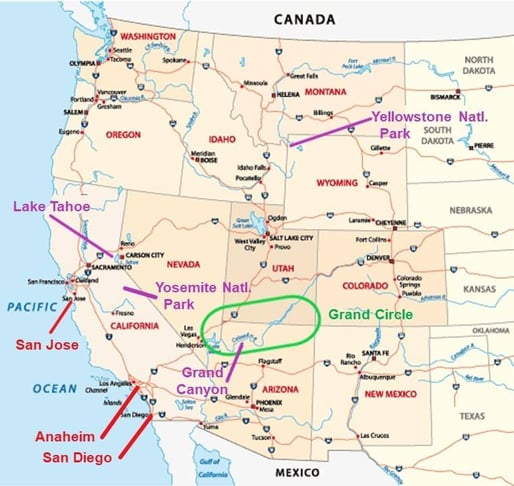 Western U.S.
Western U.S.
Some people take day trips to places like Yosemite National Park, which is 4 hours away. Lake Tahoe, which was added to our family's list of favorite places this summer, is also 4 hours away. Some of you may think that traveling is something special. This may be a common story here, I know that people drive about 5 hours from Illinois to Michigan every other week, or even every week, for work.
Of course, the background is that, in the U.S., highways are free, and a car is necessary for transportation even after you arrive at your destination, so I think the distance traveled by car may seem different from the perception in Japan.
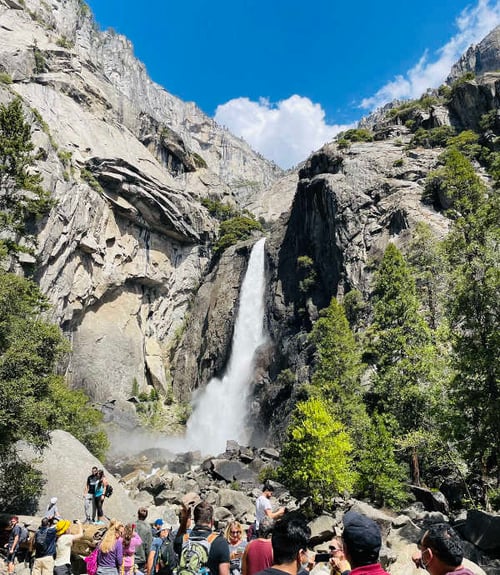 Yosemite National Park
Yosemite National Park
 Lake Tahoe
Lake Tahoe
What Are the Levels of Autonomous Driving?
So, I would like to talk about trends in cars, or "automobiles," since we spend a lot of time traveling by car in the U.S. Recently, we have heard a lot about automotive-related topics such as CASE ("Connected," "Autonomous," "Shared & Services," and "Electric") and MaaS (Mobility as a Service). This time, let me focus on Autonomous.
Although the term "automated driving" is used to describe it in one word, there are six major levels of automated driving. Level 0, 1, and 2 are the driver-driven levels, and Level 3, 4, and 5 are the system-driven levels. The big difference is between Level 2 and Level 3, where the main body of driving is different. I would like to discuss each level in more detail.
Level 0 corresponds to vehicles without ADAS (Advanced Driver-Assistance Systems), and Level 1 corresponds to vehicles equipped with automatic braking, automatic cruise control function, white line detection, etc. In Level 1, the driver is mainly responsible for driving, but with ADAS, the system assists with vehicle control, either brake/acceleration OR steering. By the way, automatic braking systems are required to be installed on new models in Japan since November 2021.
Next, Level 2. Level 2 is said to enable "hands-off" operation. Level 2 supports both brake/acceleration AND steering. It allows the driver to take their hands off the steering wheel under certain conditions. (Remember, the driver must be aware of his/her surroundings at all times!)
Next, Level 3 is where the system monitors the driving. Level 3 is said to enable "eyes-off," or the ability to take one's eyes off the road ahead while driving. The driver must be prepared to respond quickly to the system's warnings related to abnormal conditions, but under limited conditions, the system will take over all tasks. In Japan, the revised "Road Traffic Act" and the revised "Road Trucking Vehicle Act" took effect in April 2020, enabling Level 3 automated driving.
Level 4 is a level called "Brain Off." Brain Off means that the driver no longer must think about driving. Level 4 is being developed mainly for transportation service applications and is a system that allows a vehicle being driven without a driver. However, even in Level 4, there are specific domains in which automated driving is possible, and it is necessary to follow the ODD (Operational Design Domain). The ODD has different conditions depending on the automated driving system and is the point where automated driving capabilities are compared. In the U.S., there are many developments of self-driving cabs, or "robot cabs," and demonstration tests are underway. Even here in Silicon Valley, California, self-driving demonstration vehicles are on public roads and can be seen frequently.
Level 5 is what is known as fully automated driving, where the system performs all tasks in any place and under any circumstances without ODD restrictions. It is said to be difficult to achieve with current technology, but I believe it will be possible with the technology of Japan, the home of "Doraemon."**
** "Doraemon" is one of the most famous Japanese cartoons. It features the same named character as the title, a cat-shaped robot from the 22nd century.
Table. Summary of Automated Driving Level Definitions
| Level | Summary | Body of Driving * |
| Driver performs some or all dynamic driving tasks. | ||
| Level 0 | Driver performs all dynamic driving tasks. | Driver |
| Level 1 | The system performs subtasks of vehicle motion control, either steering OR brake/acceleration, in an operational design domain. | Driver |
| Level 2 | The system performs subtasks of vehicle motion control, steering AND brake/acceleration, in an operational design domain. | Driver |
| Automated driving system (when engaged) performs all dynamic driving tasks. | ||
| Level 3 | System performs all dynamic driving tasks in an operational design domain. If the system has difficulty continuing work, the driver responds appropriately to the system's request for intervention, etc. |
System (or driver if the system is unable to continue working) |
| Level 4 | The system performs all dynamic operation tasks and responses in an operational design domain when it is difficult to continue working. | System |
| Level 5 | The system performs all dynamic operation tasks and responds to cases where it is difficult to continue working without restrictions (i.e., not in an operational design domain). | System |
Now, I hope you have learned enough about the differences among the levels of autonomous driving. Will there be a discount for a level 5 car? Would level 5 self-driving cars be like 50% off? This is difficult to predict.
However, as a supplier of power management ICs for automobiles, we are wondering if we will suffer from the price reduction.
As you can imagine, it is not an easy task to realize safe and reliable autonomous driving. We would be pleased to provide ICs to play a role in the development of safe and reliable autonomous vehicles.
Regarding "play a role" mentioned above, as an IC supplier, we are making efforts in the following activities.
 Electrification of automobile by our power management ICs
Electrification of automobile by our power management ICs
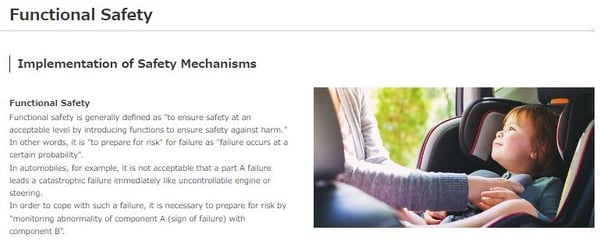 Nisshinbo Micro Devices' Approach to Functional Safety
Nisshinbo Micro Devices' Approach to Functional Safety
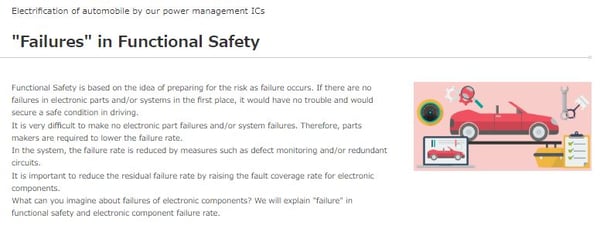 "Failures" in Functional Safety
"Failures" in Functional Safety
We also have a wide range of ICs that can contribute to functional safety. Please contact us if you have any questions.
- R3152 Series, 42V Input Window Voltage Detector
- R3154 Series, 42 V Input Window Voltage Detector with Diagnostic Function
- R3500 Series, 42 V Input 4ch Window Voltage Detector with Diagnostic Function
When Autonomous Driving Becomes Widespread…
Since I have reached the number of words required for this blog, I would like to return to the main topic: the difficulty of taking a vacation, which I briefly touched on at the beginning of this blog. Yes, what I wanted to convey in this blog after all is that traveling in the U.S. involves long-distance driving, which means that "if autonomous cars become widespread, you can work on the road and combine work and vacation" (to review my conclusion once again, it is a thinking of an enthusiastic employee in a company with a poor work environment. You might be wondering if this company is OK, lol.)
Of course, if the 10-hour drive becomes automatic and you can use the time to sleep, you will have a wider range of activities and your thinking will change. It would be easier to travel by private car than by public transport, especially if you have small children. And what people expect from their cars will also change. One of my soccer friends, who is also a senior to me, drives a Tesla car. When I asked him what he thought of it, he said, "It's a space to move around, a living room.” He also said that once you get used to the autopilot function, driving by yourself becomes a chore.
 While eating a hamburger...
While eating a hamburger...
What will cars look like in 5, 10, or 20 years? My imagination is full of ideas. I wonder if the day will come when flying cars will travel on a three-dimensional road network. At least in my daughter's generation, they will no longer have to worry about scratching one another's cars in parking lots.
See you next time. Bye.



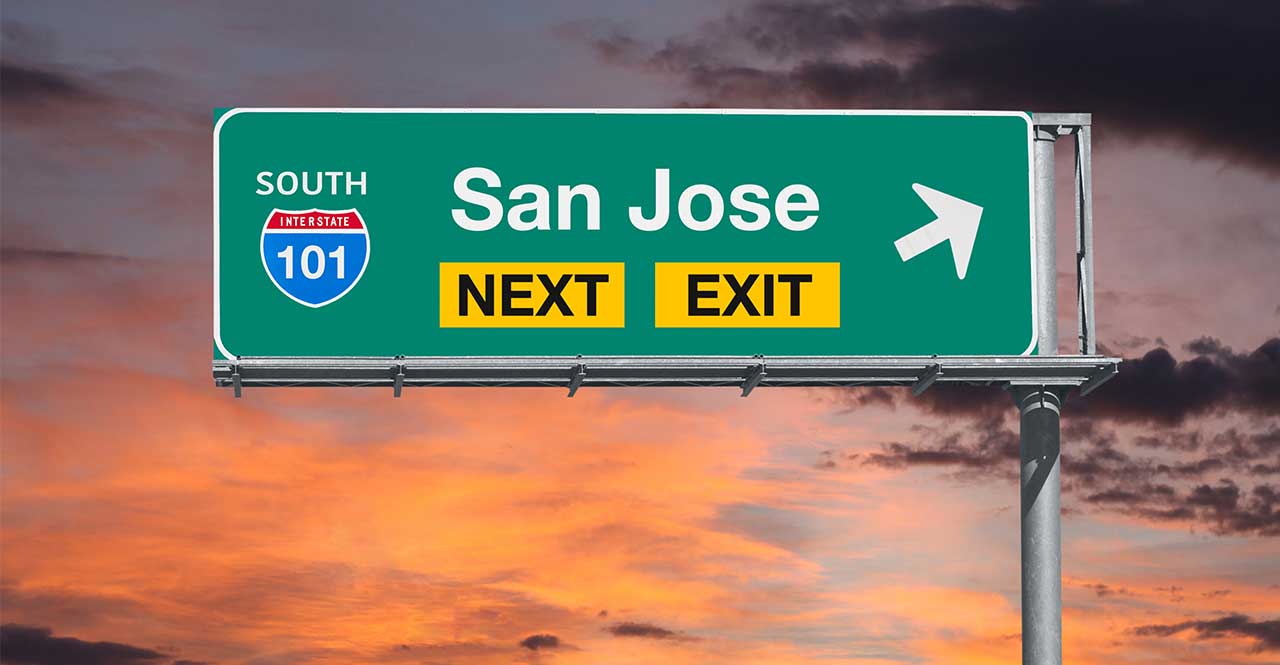
Comment